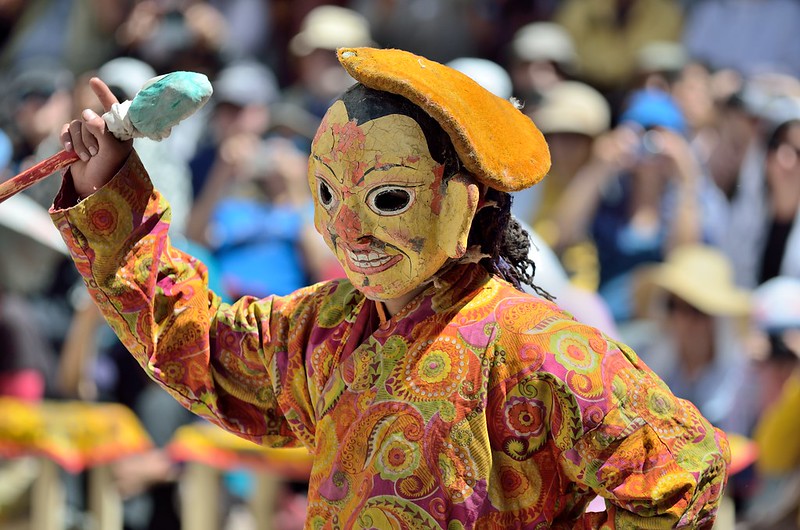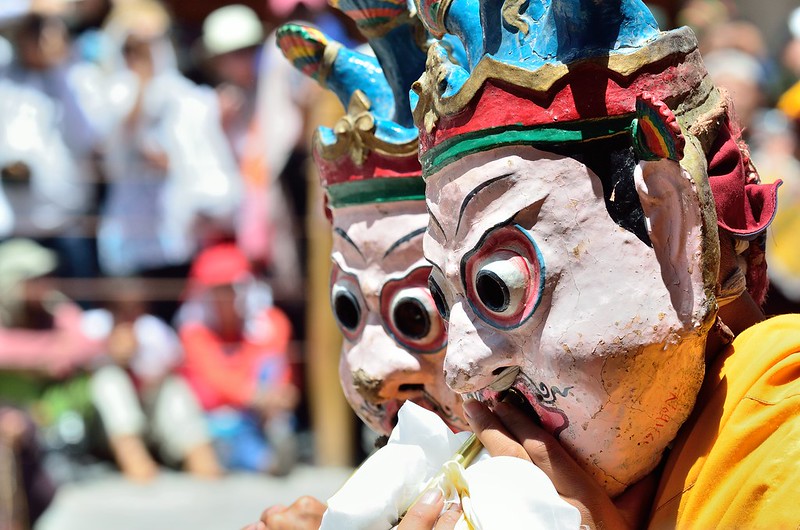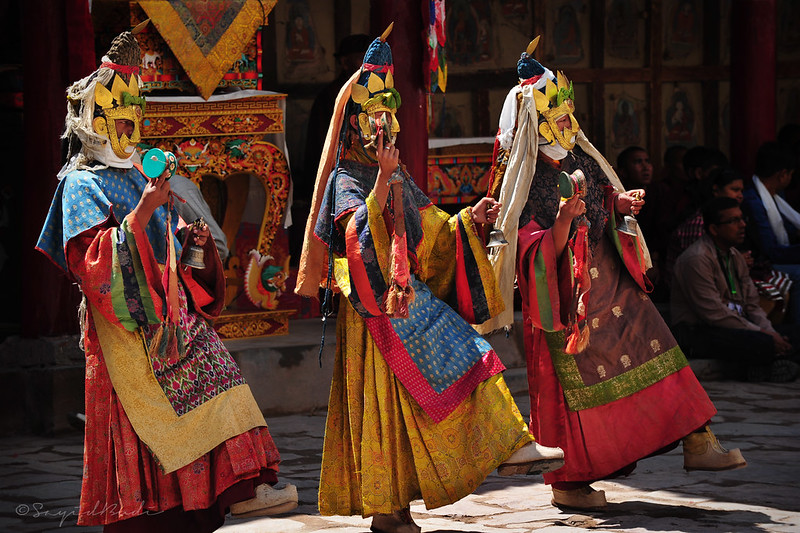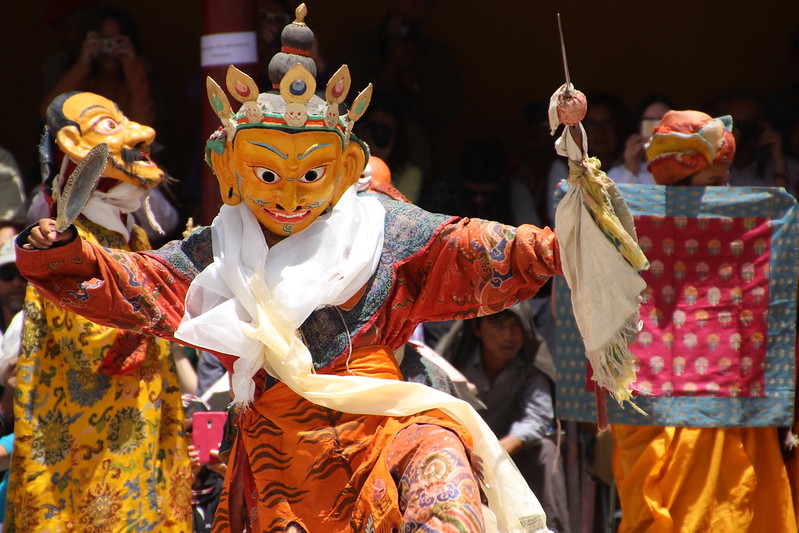Hemis Tse Chu
The Grand Festival of Dance, Color, and Prayer in the Heart of Ladakh
2026/06/30 - 2026/07/01
Every summer, the remote Hemis Monastery deep in Ladakh bursts into a festival of color, music, and swirling silks for Hemis Tse Chu. The crisp mountain air rings with the sound of horns and drums as monks, dressed in elaborate masks and brocade costumes, perform the sacred Cham dance that has fascinated pilgrims and travelers for centuries. For those seeking the essence of Ladakh’s spiritual culture and tradition, Hemis Tse Chu is an unforgettable, living celebration[1][2][3][4][5][6][7][8].
This festival is held every June or July at Hemis Monastery, about 45 km from Leh. Locals, Buddhists, and travelers from around the world gather to witness vibrant rituals, mystical dances, and the breathtaking beauty of the Himalayas[2][3][4][5][7].
Main Attractions
Cham (Masked Dance)
The highlight of Hemis Tse Chu is the Cham masked dance performed in the monastery courtyard. Monks wear intricately crafted masks representing deities, animals, and demons, and dance in circles to the beat of drums, horns, and cymbals. The story of good triumphing over evil unfolds, with the central appearance of Guru Rinpoche (Padmasambhava). The flutter of silk robes, the shimmer of gold embroidery, and the scent of juniper incense fill the air, creating a mystical and uplifting atmosphere[1][2][4][5][6].
Unveiling of the Giant Thangka (Sacred Painting)
Once every twelve years, on the morning of the festival’s second day, the monastery unveils its giant thangka (a sacred painting of Guru Rinpoche). Towering several stories high, this rare event draws pilgrims from across the Himalayas. The thangka’s vivid colors and intricate details shine in the morning sun as devotees offer katas (prayer scarves) and pray for blessings and good fortune[2][5][6].
Rituals and Key Events
The festival begins with the sound of conch shells and long horns, followed by purification rituals and offerings to the monastery’s protectors. Over two days, monks perform dances, chant mantras, and reenact mythological battles. The air is filled with prayers, fluttering flags, the warmth of stone courtyards, and sunlight, as locals and visitors share meals and stories together[3][4][6].
Costumes and Decorations
Monks wear deep red, gold, and turquoise silk costumes topped with giant masks adorned with skulls, jewels, and yak hair. The monastery is decorated with flags, butter lamps, and garlands. The coolness of stone underfoot, the flicker of butter lamps, the scent of incense, and the mountain breeze all heighten the sensory experience[2][4][5][6].
Traditional Food & Drink
Festival stalls and the monastery kitchen serve Ladakhi specialties: thukpa (noodle soup), momo (steamed dumplings), and butter tea. The earthy flavors of barley, yak butter, and mountain herbs, combined with the crisp air and the warmth of hot soup or tea, are a comfort in the high-altitude chill[5].
Cultural and Historical Background
Hemis Tse Chu celebrates the birth of Guru Rinpoche (Padmasambhava), the 8th-century master who brought Tibetan Buddhism to Ladakh. The festival began in the 18th century with the founding of Hemis Monastery, a major center of the Drukpa order. For Ladakhis, it is a time to honor ancestors and faith, and the Cham dance is a powerful ritual to purify the land and ward off misfortune[1][2][4][5][6][8].
Participant Voices
"I traveled from Delhi just for this festival, and was overwhelmed by the power and energy of the masked dances. Sharing butter tea and stories with locals was a deeply fulfilling experience." — Priya, visitor
"As someone from Ladakh, Hemis Tse Chu is part of my identity. My grandmother used to bring me, and now I watch the Cham dance with my own children. It’s a living connection to our ancestors and culture." — Tsering, Leh resident
"I’m a photographer from France, and I’ve never seen anything like the colors and rituals at Hemis. I spent hours talking with monks about the meaning of the dances, and was moved by Ladakh’s hospitality and spirituality." — Luc, visitor
Fun Facts
- The giant thangka (sacred painting) is displayed only once every 12 years, with the next unveiling scheduled for 2030[2][5].
- The Cham masked dance is believed to bring protection and good fortune to the entire region[2][4][5].
- Hemis Monastery, founded in 1672, is the richest and most influential monastery in Ladakh[8].
Festival Dates
Hemis Tse Chu is held every summer at Hemis Monastery, about 45 km from Leh. Dates change annually according to the Tibetan lunar calendar.
The event schedule is subject to change. Please check the official website for the most up-to-date information.
Information
| Name | Hemis Tse Chu |
| Country | India |
| Area | Ladakh |
| Date | 2026/06/30 - 2026/07/01 |
| Link |
Upcoming Festivals
Whirling Dervishes Festival Turkey
A Mesmerizing Dance of Divine Love
2025/12/06Mevlana Celaleddin Rumi Commemoration Ceremony ( Şeb-i Arus ) Turkey
A Whirling Journey to Divine Love
2025/12/10Dia de la Virgen de Guadalupe Mexico
A Festival Weaving Faith, Fervor, and Mexican Identity
2025/12/11L'Escalade Switzerland
Geneva’s Grand Winter Festival of Courage, Chocolate, and Community
2025/12/12Umkhosi Wokweshwama South Africa
The Zulu First Fruits Festival—A Sacred Celebration of Land, Ancestors, and Renewal
2025/12/12Lucia Festival (St. Lucia's Day) Sweden
A Festival of Light Illuminating the Nordic Darkness
2025/12/15Las Posadas Mexico
The Luminous Quest for Sacred Shelter
2025/12/22Noche de Rabanos (Night of the Radishes) Mexico
A celebration blending art, farming heritage, and cultural traditions
2025/12/23Chant of the Sybil on Majorca Spain
A Medieval Prophecy Echoes Through Majorcan Christmas
2025/12/23‘Hatajo de Negritos’ and the ‘Hatajo de Pallitas’ Peru
A Christmas Festival of Rhythm, Faith, and Afro-Andean Heritage in Peru’s Ica Region



